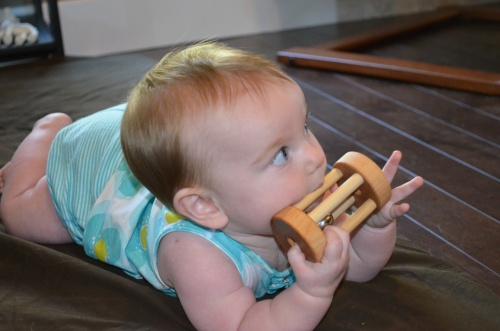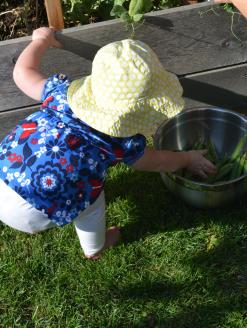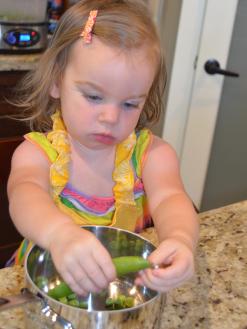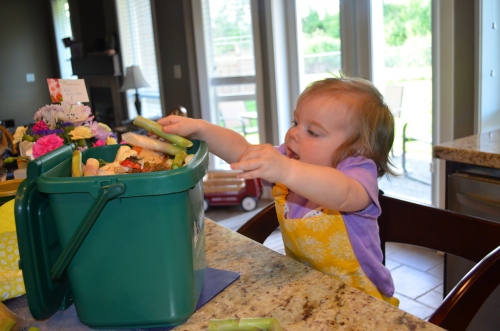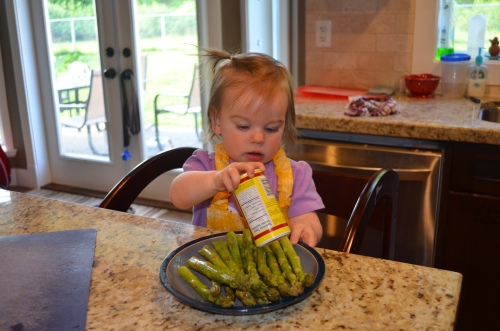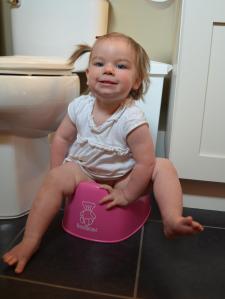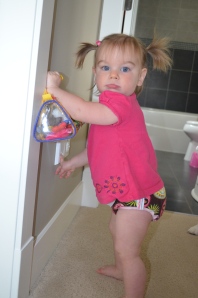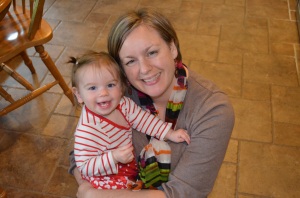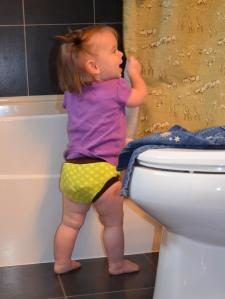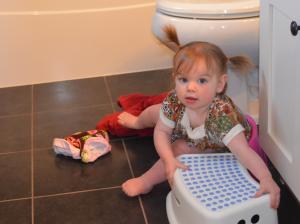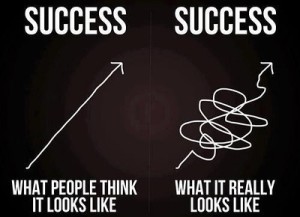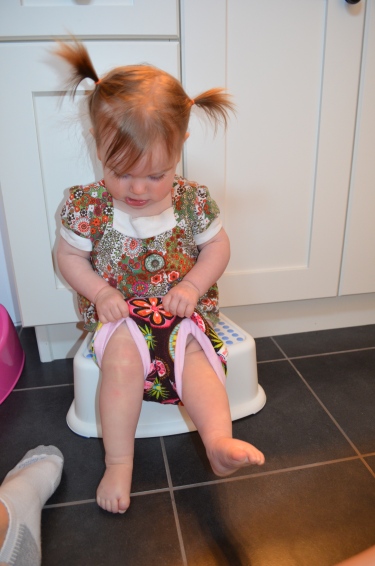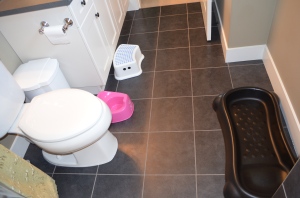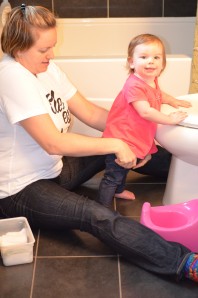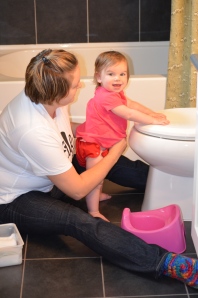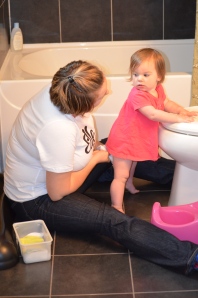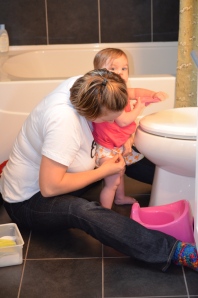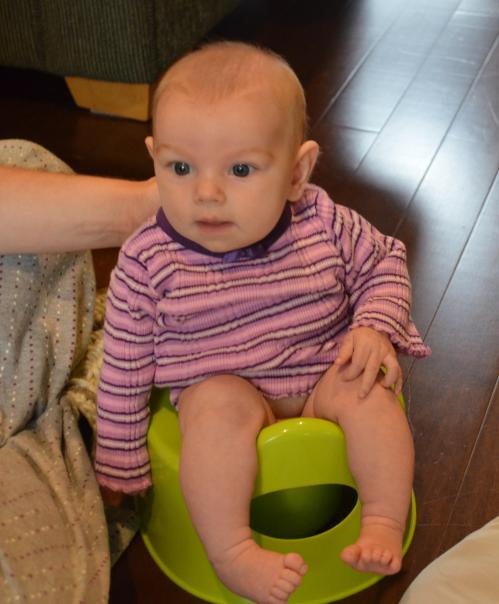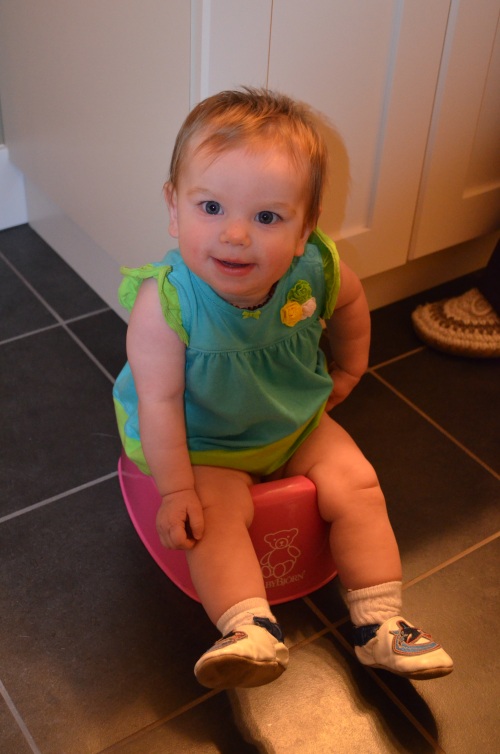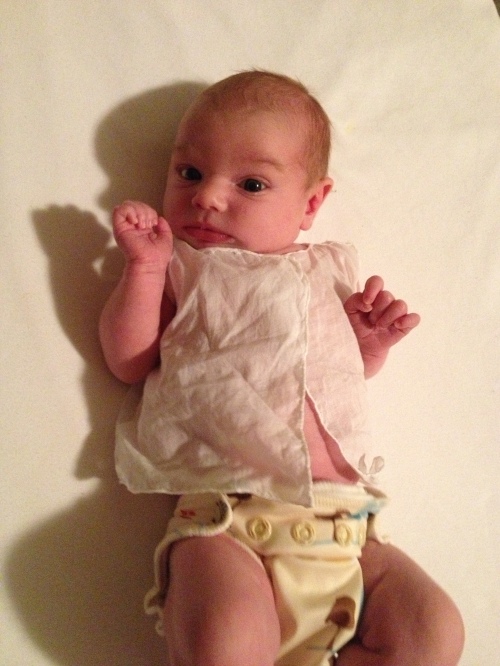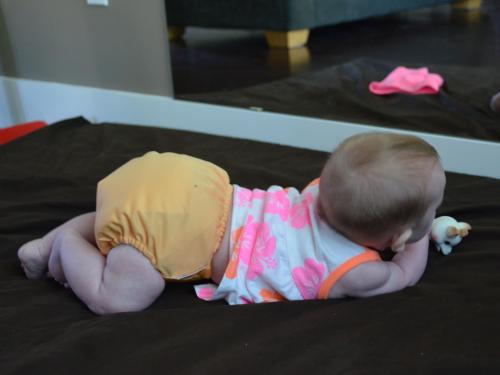By Carrie
A. is now 17 Months and is still mostly crawling and cruising around. She can definitely be considered a late walker. It was drilled into us during our Montessori training that when a child begins walking s/he will have “hands free to transform the environment”, meaning the child would be ready to take on practical life activities. While A. may not be walking, she is certainly progressing psychologically and cognitively. She’s not the same as an 11 month old who is not yet walking. It was around 12 months that she started exhibiting a stronger will (tantrums!). She has a stronger need to do things independently and become an active part of her home environment. She is ready to take on practical life activities and has been doing so for the past few months.
If you’re new to Montessori you may be asking what I mean by “practical life.” Practical life is everyday life:
- Taking care of ourselves and our children
- Taking care of things in our home environment (including yards, animals)
- Treating each other, and our materials, with care and respect
As a parent I want to create a home that is rich with opportunities for A. to contribute and gain a deep sense of belonging. I want to offer opportunities for her to develop the self-confidence of independently taking care of her personal needs. This isn’t so easy when she is still using her hands for locomotion. In our training we were asked the question “If the child is still crawling, can they participate in practical life?” I feebly answered this question at the time. I’ve had to completely re-think this now that I have child who has yet to reach the milestone of walking.
So many practical life situations require the balance and coordination utilized in walking, and the ability to carry items with two hands while walking. I look forward to introducing those to A. in the future and in the meantime I wanted to share with you some ways in which A. is beginning to do practical life as she crawls and cruises. I don’t think any of these ideas is revolutionary, nor does A. do all of them in one day. I have just been conscious of slowing down and inviting her to participate in everyday life. Having a few child-sized materials has definitely helped. While these are the activities that are a part of our day, depending on where you live, your culture, and your personal circumstances, the practical life activities that you and your child will do will vary.
 To start her day she is able to crawl independently out of her floor bed. After nursing we go to her dresser and she opens her small cupboard. She is able to choose an outfit for the day. The night before I place two outfits for her to choose from. Then we go to the bathroom to get ready for the day. It is a collaboration during undressing (I assist in taking out her arms and she pulls her pajama shirt over her head) and during dressing (she gets one leg in the pants and I assist with the second leg. She pulls it up to her knees while sitting on the stool and I assist by pulling them up all the way once she is standing). It is also a collaboration as she has a turn to brush her teeth, wash her face, and brush her hair, and then I have a turn.
To start her day she is able to crawl independently out of her floor bed. After nursing we go to her dresser and she opens her small cupboard. She is able to choose an outfit for the day. The night before I place two outfits for her to choose from. Then we go to the bathroom to get ready for the day. It is a collaboration during undressing (I assist in taking out her arms and she pulls her pajama shirt over her head) and during dressing (she gets one leg in the pants and I assist with the second leg. She pulls it up to her knees while sitting on the stool and I assist by pulling them up all the way once she is standing). It is also a collaboration as she has a turn to brush her teeth, wash her face, and brush her hair, and then I have a turn.
 We go to the kitchen and she assists in preparing breakfast. She cracks the raw eggs for fried or scrambled eggs. She peels the shell off the hard-boiled egg and uses the egg slicer to cut the egg. She puts the fruit into the colander, I wash and cut, and then she puts the fruit onto the plate. She pours water into her dry oatmeal before I cook it.
We go to the kitchen and she assists in preparing breakfast. She cracks the raw eggs for fried or scrambled eggs. She peels the shell off the hard-boiled egg and uses the egg slicer to cut the egg. She puts the fruit into the colander, I wash and cut, and then she puts the fruit onto the plate. She pours water into her dry oatmeal before I cook it.
 During meals she has been learning to use a spoon and fork. She completely self-feeds herself, often choosing to use her hands before using utensils. She likes to be given the opportunity to wipe her face at the end of the meal, and this is a collaboration as I need to wipe her face and hands before she is clean enough to play. She then goes to unlock the dogs from their dog crates (they get locked up for meal times). I love how she develops fine-motor control and unlocks various types of locks in a real, practical manner. She also treats the dogs with respect by petting them gently, hugging them, and respecting that they have limits of how much they will tolerate being crawled over.
During meals she has been learning to use a spoon and fork. She completely self-feeds herself, often choosing to use her hands before using utensils. She likes to be given the opportunity to wipe her face at the end of the meal, and this is a collaboration as I need to wipe her face and hands before she is clean enough to play. She then goes to unlock the dogs from their dog crates (they get locked up for meal times). I love how she develops fine-motor control and unlocks various types of locks in a real, practical manner. She also treats the dogs with respect by petting them gently, hugging them, and respecting that they have limits of how much they will tolerate being crawled over.
 After breakfast she often likes to help unload the dishwasher. She hands me the utensils and I put them away. This is a great opportunity for language as I name each utensil she pulls out and she tries to say it after me. For her own utensils, I give them to her to put away in her cupboard. She is learning how to match up the forks to the forks and the spoons to the spoons. A. loves to help do the laundry. She puts the dirty clothes in the washer, puts the wet clothes in the dryer, and puts the dry clothes into the laundry basket. This is a wonderful sensorial experience of dry, damp, and warm. She is tall enough now to reach the buttons, so with guidance, she pushes the power and start buttons.
After breakfast she often likes to help unload the dishwasher. She hands me the utensils and I put them away. This is a great opportunity for language as I name each utensil she pulls out and she tries to say it after me. For her own utensils, I give them to her to put away in her cupboard. She is learning how to match up the forks to the forks and the spoons to the spoons. A. loves to help do the laundry. She puts the dirty clothes in the washer, puts the wet clothes in the dryer, and puts the dry clothes into the laundry basket. This is a wonderful sensorial experience of dry, damp, and warm. She is tall enough now to reach the buttons, so with guidance, she pushes the power and start buttons.
 We also like to bake together. A. loves to put on her apron. She pours, peels the bananas (for banana muffins), stirs, is learning to open containers, mixes things together by hand, and puts liners in the muffin tins.
We also like to bake together. A. loves to put on her apron. She pours, peels the bananas (for banana muffins), stirs, is learning to open containers, mixes things together by hand, and puts liners in the muffin tins.
 Lunch time is eaten at her small table and chair. It’s hard to set the table when she is still crawling so currently I’m starting by having her bring over the placemats (while I try to ignore the dog hair that gets picked up as they are dragged across the floor). She then goes to sit down at her table independently when I ask her to do so. She peels the banana peels off her banana slices, peels her mandarin oranges, picks the edamame beans out of the shell and puts the organic waste into her small bucket. She is learning to sign ‘please’ when she would like more of something (she signs ‘more’ quite well). Again, she self-feeds herself and I found it was easier for her to learn self-feeding with utensils at her small table. She is able to pour water into her glass, albeit not from the spout yet. She continues to make little spills and often still attempts to drink out of the pitcher afterwards. She likes to wipe her table at the end of the meal to clean-up. She will bring over the dustpan and brush for me to use to clean the floor. She likes to dump her little bucket of organic waste into the compost bin.
Lunch time is eaten at her small table and chair. It’s hard to set the table when she is still crawling so currently I’m starting by having her bring over the placemats (while I try to ignore the dog hair that gets picked up as they are dragged across the floor). She then goes to sit down at her table independently when I ask her to do so. She peels the banana peels off her banana slices, peels her mandarin oranges, picks the edamame beans out of the shell and puts the organic waste into her small bucket. She is learning to sign ‘please’ when she would like more of something (she signs ‘more’ quite well). Again, she self-feeds herself and I found it was easier for her to learn self-feeding with utensils at her small table. She is able to pour water into her glass, albeit not from the spout yet. She continues to make little spills and often still attempts to drink out of the pitcher afterwards. She likes to wipe her table at the end of the meal to clean-up. She will bring over the dustpan and brush for me to use to clean the floor. She likes to dump her little bucket of organic waste into the compost bin.
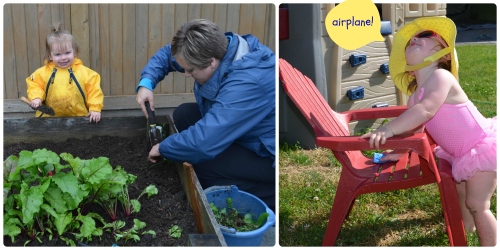 In the afternoon we might do some work outdoors. A. loves to be out in the garden! While she isn’t truly helping in the garden quite yet, she loves to transfer dirt with her own tools while I do the weeding. She enjoys picking the leaves and I take deep breaths as I guide her towards the appropriate leaves to pick (lettuce, spinach, and beet leaves). The vegetable boxes are the perfect cruising height for her. She is having fun harvesting the carrots and beets as she pulls them out of the soil (I loosen them first). She also likes to help clean her toys and chair by scrubbing with a brush or a sponge. I’ll hose down the toys while she continues to enjoy playing with the bubbles or transferring water between two buckets. I really like the sensorial experiences she is gaining by handling soil, vegetable leaves, and soapy water.
In the afternoon we might do some work outdoors. A. loves to be out in the garden! While she isn’t truly helping in the garden quite yet, she loves to transfer dirt with her own tools while I do the weeding. She enjoys picking the leaves and I take deep breaths as I guide her towards the appropriate leaves to pick (lettuce, spinach, and beet leaves). The vegetable boxes are the perfect cruising height for her. She is having fun harvesting the carrots and beets as she pulls them out of the soil (I loosen them first). She also likes to help clean her toys and chair by scrubbing with a brush or a sponge. I’ll hose down the toys while she continues to enjoy playing with the bubbles or transferring water between two buckets. I really like the sensorial experiences she is gaining by handling soil, vegetable leaves, and soapy water.
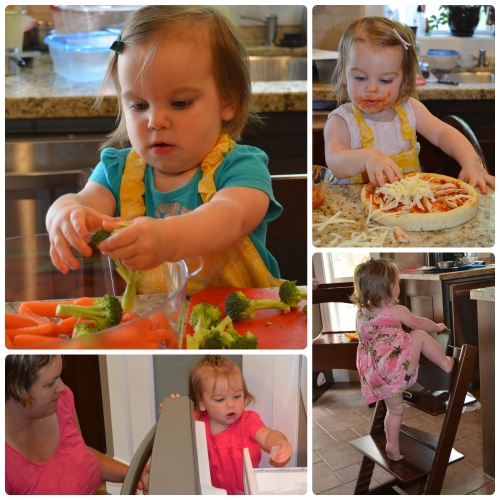 Helping to prepare dinner is fun as she then collaborates with both Mommy and Daddy. She transfers the vegetables to the steamer basket. She puts the cut up vegetables into the salad. She puts the organic waste into the compost bin. She pours the dry rice or quinoa into the pot and pours the water into the pot before I cook it. She adds the spices to foods. When we make our own pizza’s she scoops the sauce and spreads it, then adds the meat and cheese, chooses to not add the vegetables, and has a pre-dinner snack (still working on self-control). She puts the ice in Mommy’s glass. She climbs into her Tripp Trapp high chair to eat dinner as a family (we’ve since removed the baby insert seat). Preparing food together offers infinite opportunities for language enrichment.
Helping to prepare dinner is fun as she then collaborates with both Mommy and Daddy. She transfers the vegetables to the steamer basket. She puts the cut up vegetables into the salad. She puts the organic waste into the compost bin. She pours the dry rice or quinoa into the pot and pours the water into the pot before I cook it. She adds the spices to foods. When we make our own pizza’s she scoops the sauce and spreads it, then adds the meat and cheese, chooses to not add the vegetables, and has a pre-dinner snack (still working on self-control). She puts the ice in Mommy’s glass. She climbs into her Tripp Trapp high chair to eat dinner as a family (we’ve since removed the baby insert seat). Preparing food together offers infinite opportunities for language enrichment.
 After dinner it is time to get ready for bed. Throughout the day she has been given multiple opportunities to use the potty and multiple opportunities to pull up underwear and pants. She hasn’t gotten into pulling down underwear and pants yet. Before her bath she crawls over to her laundry basket with her dirty clothes in hand to place them in the basket. During her bath it is collaboration again as she uses the cloth to wash herself and then I wash her. I dry her off and she opens the diaper cream and her face cream containers so I can apply them. She loves to dip her finger into the face cream and put some on her cheeks. She collaborates in putting on her pajamas. Then she’s off to sleep in her floor bed.
After dinner it is time to get ready for bed. Throughout the day she has been given multiple opportunities to use the potty and multiple opportunities to pull up underwear and pants. She hasn’t gotten into pulling down underwear and pants yet. Before her bath she crawls over to her laundry basket with her dirty clothes in hand to place them in the basket. During her bath it is collaboration again as she uses the cloth to wash herself and then I wash her. I dry her off and she opens the diaper cream and her face cream containers so I can apply them. She loves to dip her finger into the face cream and put some on her cheeks. She collaborates in putting on her pajamas. Then she’s off to sleep in her floor bed.
My own efficiency has been slowed down to include A. in many of these activities yet the activities become more joyful for me as I watch her developing greater motor control, independent skills, have rich sensorial experiences, a greater vocabulary, and self-esteem that she has contributed and done important work. I find myself pausing and just smiling as she takes on many of these tasks. She is also a happier, more content child, which makes the day more enjoyable for both of us.
Observation of the child shows that normally he has the desire to act independently; he wants to carry things, to dress and undress alone, to feed himself, and it is not by adult suggestion that he tries to do these things. On the contrary, his urge is so strong that our efforts are usually spent in trying to restrain him; but when we do this, we are fighting nature, not the will of the child. ~Maria Montessori, Education for a New World
While we do practical life activities our entire lives, allowing the child to follow their natural instincts to do these activities has a much deeper impact on a child who is under 6 years of age. At this age the child is going through a huge developmental stage of constructing their personality. While you and I prepare a meal and do the laundry to complete a task, the young child does these activities to feed their soul. Children have a deep need for their movement to be connected to an intelligent and purposeful activity. Children have a deep desire to belong to the environment that they are in by participating in the activity that surrounds them.
Children are therefore at an age when they are greatly interested in movements and seem to be anxious to learn how they should move about. They are passing through that epoch of their lives when they must become masters of their own actions. Physiologically we may say that their muscles and nerves are passing through a period when they are learning how to work harmoniously together. Successful passage through this period is of utmost importance for an individual’s ultimate perfection. A good beginning here is most important for a child’s future. ~Maria Montessori, The Discovery of the Child
Join the conversation! How have you involved your crawling and cruising child in everyday, practical life?
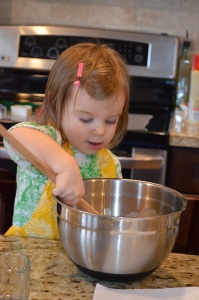 Pour flour, water, gelatin, and corn syrup into bowl. Give it a good stir.
Pour flour, water, gelatin, and corn syrup into bowl. Give it a good stir.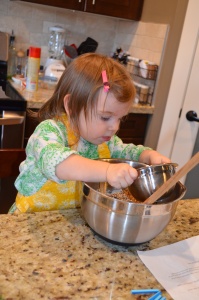 Pour in the bird seed. Stir it all together.
Pour in the bird seed. Stir it all together.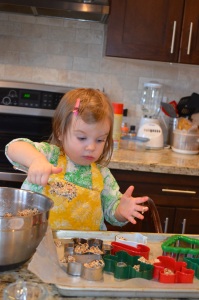 Scoop into Christmas cookie cutters.
Scoop into Christmas cookie cutters.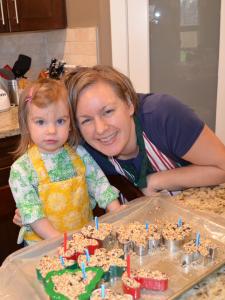 Insert straw pieces and leave to harden.
Insert straw pieces and leave to harden.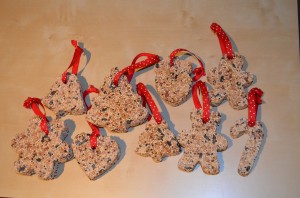 Tie a piece of ribbon through the hole. Hang on a tree outside for the birds to enjoy.
Tie a piece of ribbon through the hole. Hang on a tree outside for the birds to enjoy. Don’t forget a card! Crayons and dot stickers allowed A. to add her personal touch.
Don’t forget a card! Crayons and dot stickers allowed A. to add her personal touch.

 3 Months:
3 Months: 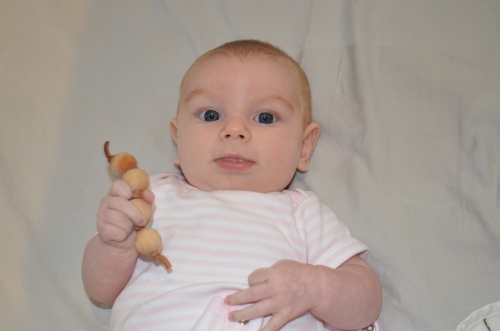 4 Months:
4 Months: 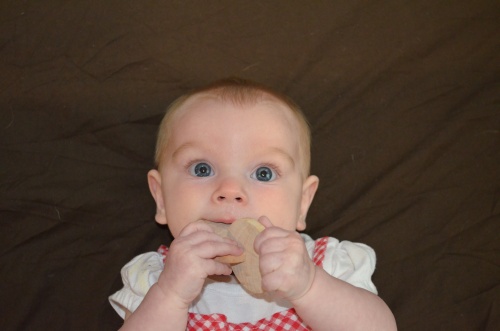 5 Months:
5 Months: 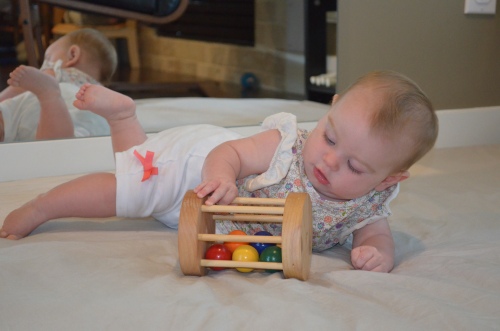 6 Months:
6 Months: 